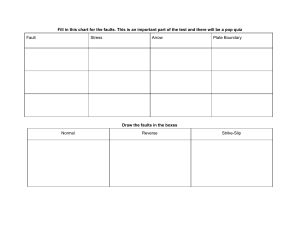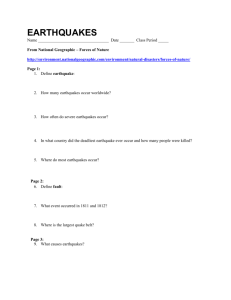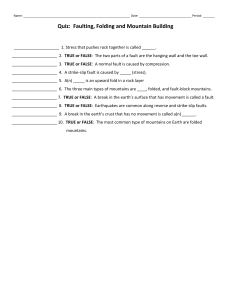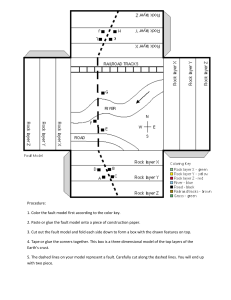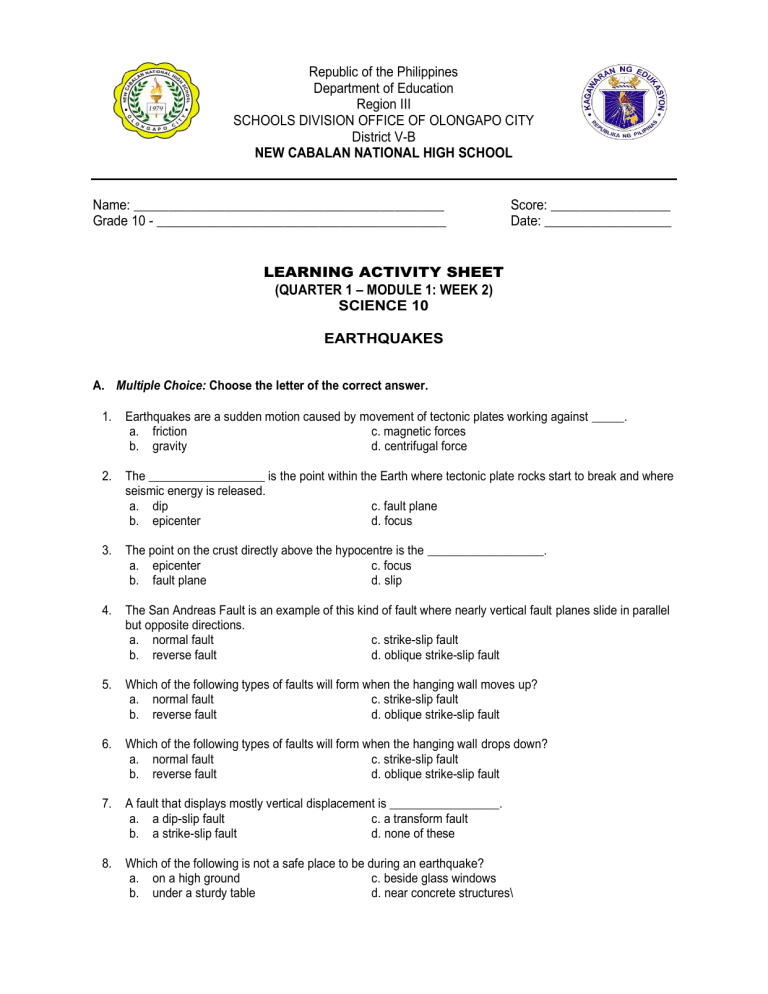
Republic of the Philippines Department of Education Region III SCHOOLS DIVISION OFFICE OF OLONGAPO CITY District V-B NEW CABALAN NATIONAL HIGH SCHOOL Name: ____________________________________________ Grade 10 - _________________________________________ Score: _________________ Date: __________________ LEARNING ACTIVITY SHEET (QUARTER 1 – MODULE 1: WEEK 2) SCIENCE 10 EARTHQUAKES A. Multiple Choice: Choose the letter of the correct answer. 1. Earthquakes are a sudden motion caused by movement of tectonic plates working against _____. a. friction c. magnetic forces b. gravity d. centrifugal force 2. The __________________ is the point within the Earth where tectonic plate rocks start to break and where seismic energy is released. a. dip c. fault plane b. epicenter d. focus 3. The point on the crust directly above the hypocentre is the __________________. a. epicenter c. focus b. fault plane d. slip 4. The San Andreas Fault is an example of this kind of fault where nearly vertical fault planes slide in parallel but opposite directions. a. normal fault c. strike-slip fault b. reverse fault d. oblique strike-slip fault 5. Which of the following types of faults will form when the hanging wall moves up? a. normal fault c. strike-slip fault b. reverse fault d. oblique strike-slip fault 6. Which of the following types of faults will form when the hanging wall drops down? a. normal fault c. strike-slip fault b. reverse fault d. oblique strike-slip fault 7. A fault that displays mostly vertical displacement is _________________. a. a dip-slip fault c. a transform fault b. a strike-slip fault d. none of these 8. Which of the following is not a safe place to be during an earthquake? a. on a high ground c. beside glass windows b. under a sturdy table d. near concrete structures\ 9-10. In the following illustration what do you call location (9) ___ and (10) ___? (9) location at Earth’s surface 9. a. b. c. d. fault plane focus fault line epicenter 10. a. fault plane b. focus c. fault line d. epicenter (10) location in Earth’s interior B. Completion: Complete each statement by choosing the correct word/s from the word bank given below. 1. Every year there are ________________ of earthquakes all around the world. 2. The reason we have earthquakes is because the Earth’s surface is really pretty ________________. 3-4. Earth’s surface is floating on ________________ or ________________ rock. 5. Earth’s surface is broken into ________________. 6. The Earth’s surface is made of ________________ plates that are floating on molten rock. 7. As the plates move, the plate movement causes cracks, and the cracks are called ________________. 8. The faults can store ________________ like a spring. 9. When energy stored in the plates is released, sometimes we get an ________________. 10. Scientists measure movement of Earth’s surface with ________________, (measuring shaking). 11. The record of the Earth’s movement made with this device is called a ________________. 12-13. A normal earthquake is ______________ that gets released as the rock or ground _____________. 14. Scientist not only feel earthquakes, they _________________________ them. 15. Scientists “connect the dots” to find the _________________ of an earthquake. Word Bank faults stored up energy epicenter thousands tectonic earthquake molten seismograph breaks liquid flexible measure energy big plates seismometers C. True or False: Write T if you think the statement is true and F if false. 1. 2. 3. 4. 5. Earthquakes occur only once or twice a year. _______ The Earth’s surface is very rigid. _______ Earth’s surface floats on molten rock. _______ Tectonic plates are very small. _______ In most earthquakes, faults are vertical. _______
